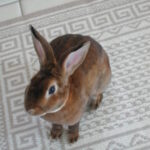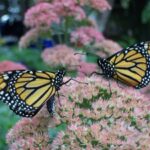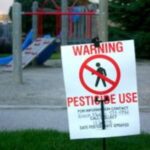Our environment is filled with poisonous substances that are dangerous to humans as well as our pets. Rabbits are notorious for nibbling on articles that aren’t necessarily good for their health which includes many common plants that can potentially dangerous, even deadly. While many plants are toxic to animals, rabbits can be more susceptible as it can take the smallest amount of toxins to cause irreversible damage. There are literally hundreds of plants or portions of plants that are poisonous to rabbits but there are a few that are more common.
MILKWEED
One of the most common plant poisoning in rabbits is milkweed poisoning. Almost all cases of poisoning by this plant have been reported only in the southwestern United States. The poisoning occurs when rabbits have been given hay that was harvested containing the wooly pod milkweed. It only takes ¼ of a percent of the rabbit’s body weight of green milkweed to kill a rabbit. Usually the toxin causes paralysis in the neck muscles and is sometimes referred to as “head down disease”. If the rabbit survives the poisoning, an owner will need to provide nursing care until the rabbit has recovered.
FRUITS & VEGETABLES
Many common fruits are given regularly to rabbits as treats that they truly enjoy. However, the seeds of the apple and pear and the pits of apricots contain cyanide and are poisonous to rabbits and should always be removed before given to your pet for consumption. Other poisonous foods include the avocado, certain parts of the potato and the tomato plant, among others.
OTHER TOXIC PLANTS INCLUDE:
Acokanthera
African evergreen
African rue
Agapanthus
Alsike clover
Amanita
Amaryllis
Amaryllis belladonna
Anemone
Angel trumpet tree
Anthurium
Apple seeds
Apple leaf croton
Apricot pits
Arrowgrass
Arrowhead vine
Asparagus fern
Atropa belladonna
Autumn crocus
Avocado
Azalea
Baccharis
Balsam
Balsam pear
Baneberry
Beach pea
Beargrass
Beefsteak plant
Begonia
Belladonna lily
Betel nut palm
Bird of paradise
Bird of paradise bush
Bittersweet
Bitterweed
Black henbane
Black locust
Black nightshade
Black root
Bladderpod
Bleeding heart
Bloodroot
Bluebonnet
Blue cohosh
Blue-green algae
Bog Kalmia
Boston ivy
Bottlebrush
Boxwood
Bracken fern
Branching ivy
Broomcorn
Broomweed
Buckeye
Buckthorn
Bull nettle
Bunchberry
Burroweed
Buttercup
Butterfly weed
Cactus thorn
Caesalpinia
Caladium
Calendula
Calico bush
California fern
California geranium
California holly
Calla lily
Candelabra cactus
Cardinal flower
Carnation
Carolina jessamine
Carolina Laurel Cherry
Casava
Cassine
Castor bean
Century plant
Ceriman
Chalice vine
Cherries
Cherry laurel
Chinaberry tree
Chinese evergreen
Chives
Chokecherry
Christmas berry
Christmas candle
Christmas rose
Cineraria
Clematis
Cloak fern
Clover, Alsike
Cocklebur
Coffeebean
Cohosh
Colorado rubberweed
Columbine
Common privet
Coral berry
Coral plant
Cordatum
Corn cockle
Corn lily
Corn plant
Cotoneaster
Covotillo
Cowslip
Crab’s eye
Crocus
Croton
Crown-of-thorns
Crown vetch
Crow poison
Cuban laurel
Cuckoopint
Curcas bean
Cutleaf philodendron
Cycads
Cyclamen
Daffodil
Daisy
Daphne
Datura
Deadly amanita
Deadly nightshade
Death-camas
Death cup
Delphinium
Desert tobacco
Destroying angel
Devil’s ivy
Devil’s tomato
Dianthus
Dieffenbachia
Dogbane
Dogwood
Doll’s Eyes
Dracaena palm
Dragon tree
Drymary
Dumb cane
Durra
Dutchman’s breeches
Dutchman’s pipe
Eggplant-the fruit is not toxic, only the plant
Elaine
Elderberry
Emerald duke
Emerald feather
English laurel
Euonymus
Euphorbia
Evening trumpet
Exotica perfection
Eyebane
False henbane
False hellebore
False parsley
Fiddle-leaf fig
Fiddleneck
Firecracker
Firethorn
Fireweed
Florida beauty
Fluffy ruffles
Fly agaric
Fly poison
Fool’s parsley
Four o’clock
Foxglove
Foxwood
Frijolito
Fruit salad plant
Garden sorrel
Garlic
Gelsemium
Geranium, California
German ivy
Ghostweed
Giant dumbcane
Glacier ivy
Gladiola
Glecoma hederacea
Glory lily
Goatweed
Gold dieffenbachia
Gold dust dracaena
Goldenchain tree
Golden pothos
Gold-toothed aloe
Greasewood
Green-gold nephythytis
Ground ivy
Groundsel
Groundsel
Guajillo
Halogeton
Hawaiian baby wood rose
Heart ivy
Heartleaf
Heavenly bamboo
Hedge apples
Hellebore
Hemlock
Henbane, Black
Hogwort
Holly
Horsebrush
Horsechestnut
Horse nettle
Horsetail reed
Hyacinth
Hydrangea
Impatiens
Indian hemp
Indian laurel
Indian rubber plant
Indian tobacco
Indian turnip
Indigo
Inkberry
Inkweed
Iris
Jack-in-the-pulpit
Jamestown weed
Jatropha
Java bean
Jequirity bean
Jerusalem cherry
Jessamine
Jimmy fern
Jimson weed
Johnson grass
Juniper
Kafir
Kalmia
Klamath weed
Laburnum
Lady slipper
Lambkill
Lantana camara
Larkspur
Lecheguilla
Ligustrum
Lily of the valley
Lobelia
Locoweed
Lords-and-ladies
Lupine
Machineel
Madagascar dragon tree
Majesty
Mandrake
Marble queen
Marijuana
Marsh marigold
Mayapple
Mescal
Mescal bean
Mesquite
Mexican breadfruit
Mexicantes
Milkvetch
Milkweed
Milo
Miniature croton
Mistletoe
Moccasin flower
Monkshood
Moonseed
Mother-in-law
Mountain laurel
Mushroom
Narcissus
Natal cherry
Nephthytis
Needlepoint ivy
Nicotiana
Night-blooming jasmine
Nightshade
Nightshade
Oaks including the acorns
Oleander
Onion
Orange milkweed
Orange sneezeweed
Oxalis
Palma christi
Panda
Paradise plant
Parlor ivy
Parsnip
Partridge breast
Peach pits
Pear seeds
Pencilbush
Pencil cactus
Peony
Peregrina
Perill mint
Periwinkle
Peyote
Philodendron
Pigweed
Pingue
Pinks
Plum seeds
Plumosa fern
Poinciana
Poinsettia
Poison hemlock
Poison nut
Poison oak
Poison parsnip
Pokeberry
Pokeroot
Poke salad
Pokeweed
Poppy, except California
Pot marigold
Pot mum
Potato-any part that is green and the eyes that grow on the potato
Pothos
Precatory bean
Prickly copperweed
Prickly poppy
Primrose
Primula
Privet
Purge nut
Purple sesbane
Psychic nut
Pyracantha
Queen Anne’s Lace
Ranunculus
Rattlebox
Rattleweed
Rayless goldenrod
Red emerald
Red-margined dracaena
Red princess
Red sage
Rhododendron
Rhubarb
Ribbon plant
Ripple ivy
Rosary bean
Rosary pea
Rosebay
Rosemary
Rum cherry
Sacahuista
Saddle leaf philodendron
Sage
Sago palm
Sand begonia
Satin pothos
Schefflera
Scotch broom
Senecio
Senna bean
Sesbane
Shamrock plant
Sheep laurel
Silverleaf
Silverling
Silver pothos
Skunk cabbage
Slinkweed
Snapdragon
Snapweed
Snowdrop
Snow-on-the-mountain
Solanum
Solomon’s seal
Sorghum
Spathe flower
Spider mum
Split-leaf philodendron
Spoonflower
Spotted dumb cane
Sprengeri fern
Spurge
Squill
Squirrel corn
Staggergrass
Star of Bethlehem
Stinkweed
St. Johnswort
Stranomium
String of beads
Striped dracaena
Sudan grass
Swamp laurel
Sweet pea
Sweet William
Swiss cheese plant
Sweetheart ivy
Tansy
Tansy ragwort
Taro
Taro vine
Thorn apple
Tiger lily
Toadstools
Tobacco
Tomato plant
Touch-me-not
Toyon
Tree philodendron
Tropic snow
Trumpet plant
Trumpet vine
Tullidora
Turpentine weed
Umbrella plant
Variegated philodendron
Victoria regia
Violet
Virginia creeper
Warneckei dracaena
Water hemlock
White snakeroot
Windflower
Wisteria
Wolfsbane
Woodbine
Woodrose
Woody nightshade
Yam bean-roots
Yaupon holly
Yellow knapweed
Yellow jasmine
Yellow oleander
Yellow star thistle
Yerba
Yew
This is an extensive list of toxic plants to rabbits but should not be considered as a complete list. Some of the plants listed may have parts of the plant that are not poisonous such as the flowers but it would be safe to keep all parts of the plant out of reach of your rabbit. Rabbit owners should never feed their pets any type of fruit, vegetable, plant or any part of a plant unless they are certain it is safe. If you suspect your rabbit has consumed something poisonous, seek veterinarian care immediately.
References:
THE RABBIT HANDBOOK by Karen Gendron, copyright 2000
COMPLETE CARE MADE EASY RABBITS by Virginia Parker Guidry, copyright 2001



